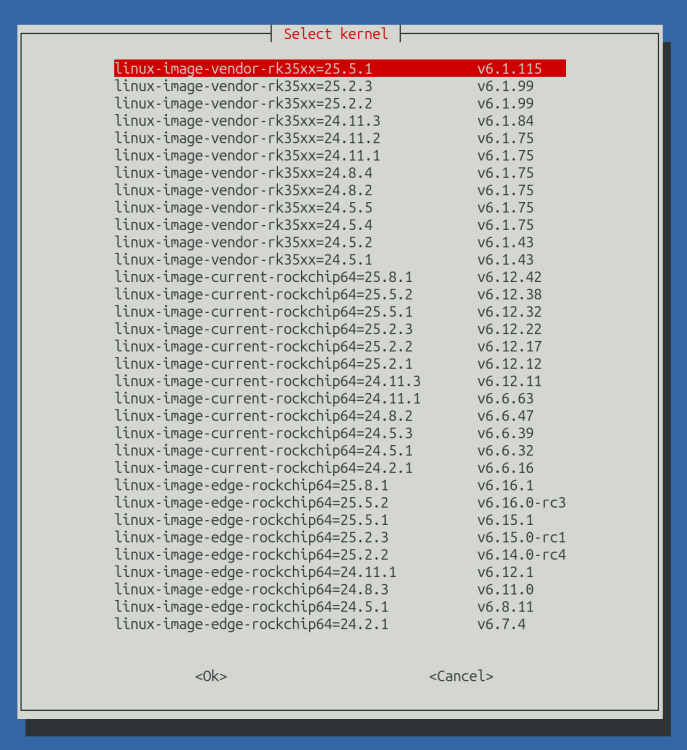All Activity
- Past hour
-
I also encountered this trouble with image corruption. Here's my small research I've made: 1. This appears to be for newer images witch use GPT schema instead of MBR one. I've tried to flash same SD cards (Transcend 1x A1 & 2x A2 class) with orangepi zero2w image from community support build which still comes with MBR schema and had no trouble at all. I've used Rufus 4.9, USBImager and dd from WSL2 for tests. Whoever, images for orangepi 3b & orangepi 5plus already comes with GPT partition schema and flashing them with any software in all combinations of eject time or way (safe or not) always lead to broken GPT table and initramfs on SBC boot. 2. I'm using WSL2 with Ubuntu 24 LTS and usbipd for linking USB devices. After SD flash on Windows side with Rufus or USBImager I'm attach SD card to WSL2 and check it state immediately. Here's log of this actions (I'm out of free SD cards so first part with image will be from regular USB flash drive). Rufus output: Opened \\.\PhysicalDrive2 for exclusive write access Requesting logical volume handle... ++++++++++++++++++++++++++++++++++++++++++++++++++++++++++++++++++++++++++++++++ Opened \\.\PhysicalDrive2 for shared write access Timeout while waiting for logical drive Found USB 3.0 device 'Kingston DT microDuo 3C USB Device' (0951:16AE) No logical drive found (unpartitioned?) 1 device found No volume information for drive 0x82 Disk type: Removable, Disk size: 64 GB, Sector size: 512 bytes Cylinders: 7538, Tracks per cylinder: 255, Sectors per track: 63 Partition type: GPT, NB Partitions: 1 Disk GUID: {61DF6BA5-465D-4529-80C4-5D4BB9D0852F} Max parts: 128, Start Offset: 1048576, Usable = 62007524864 bytes Partition 1: Type: Linux Boot Partition (ARM64) Name: 'rootfs' Detected File System: ext4 ID: {22DE0E86-86CD-4366-AF3C-07E25D0E77FA} Size: 5.9 GB (6382682112 bytes) Start Sector: 32768, Attributes: 0x0000000000000000 WSL2 sudo parted -l output: /mnt/c/Users/mevep$ sudo parted -l Error: The primary GPT table is corrupt, but the backup appears OK, so that will be used. OK/Cancel? OK Model: Kingston DT microDuo 3C (scsi) Disk /dev/sdg: 62.0GB Sector size (logical/physical): 512B/512B Partition Table: gpt Disk Flags: Number Start End Size File system Name Flags 1 16.8MB 6399MB 6383MB ext4 rootfs Trying to mount: /mnt/c/Users/mevep$ sudo mount /dev/sdg1 /mnt/mp mount: /mnt/mp: special device /dev/sdg1 does not exist. dmesg(1) may have more information after failed mount system call. gdisk output: /mnt/c/Users/mevep$ sudo gdisk /dev/sdg GPT fdisk (gdisk) version 1.0.10 Caution! After loading partitions, the CRC doesn't check out! Warning! Main partition table CRC mismatch! Loaded backup partition table instead of main partition table! Warning! One or more CRCs don't match. You should repair the disk! Main header: OK Backup header: OK Main partition table: ERROR Backup partition table: OK Partition table scan: MBR: protective BSD: not present APM: not present GPT: damaged **************************************************************************** Caution: Found protective or hybrid MBR and corrupt GPT. Using GPT, but disk verification and recovery are STRONGLY recommended. **************************************************************************** Recovery/transformation command (? for help): v Problem: The CRC for the main partition table is invalid. This table may be corrupt. Consider loading the backup partition table ('c' on the recovery & transformation menu). This report may be a false alarm if you've already corrected other problems. Warning: There is a gap between the main metadata (sector 1) and the main partition table (sector 2016). This is helpful in some exotic configurations, but is generally ill-advised. Using 'j' on the experts' menu can adjust this gap. Identified 1 problems! Output after gdisk r c w commands (everything is ok now): Recovery/transformation command (? for help): c Warning! This will probably do weird things if you've converted an MBR to GPT form and haven't yet saved the GPT! Proceed? (Y/N): Y Recovery/transformation command (? for help): W Final checks complete. About to write GPT data. THIS WILL OVERWRITE EXISTING PARTITIONS!! Do you want to proceed? (Y/N): Y OK; writing new GUID partition table (GPT) to /dev/sdg. The operation has completed successfully. /mnt/c/Users/mevep$ sudo parted -l Model: Kingston DT microDuo 3C (scsi) Disk /dev/sdg: 62.0GB Sector size (logical/physical): 512B/512B Partition Table: gpt Disk Flags: Number Start End Size File system Name Flags 1 16.8MB 6399MB 6383MB ext4 rootfs /mnt/c/Users/mevep$ sudo mount /dev/sdg1 /mnt/mp /mnt/c/Users/mevep$ ls /mnt/mp bin boot etc lib lost+found mnt proc run sbin.usr-is-merged snap sys usr bin.usr-is-merged dev home lib.usr-is-merged media opt root sbin selinux srv tmp var Also I have UART logs of trying to boot from SD card SBC without any changes after image burn, but nothing interesting there - it just goes initramfs after kernel boot start process. Added log file to this post for orangepi 3b. Same appears for orangepi 5plus. Image build with armbian-build by me from latest . COM6_2025_08_21.txtCOM6_2025_08_21.txt 3. After SD card recovery everything boots and works fine. Tested on custom build images with armbian-build commit 1d89b0e1e0e6a8b053a94a41a8d0b961f38a9fae for orangepi 3b & 5plus. Maybe it will help somehow :^)
- Today
-

immich created via armbian-config dont work
laibsch replied to Zsolt Tóth's topic in Software, Applications, Userspace
oh, come on, man! https://letmegooglethat.com/?q=docker+external+directory -

immich created via armbian-config dont work
Zsolt Tóth replied to Zsolt Tóth's topic in Software, Applications, Userspace
Thank you. How can i add an external directory? Any config file or something? -

No Ethernet or Wifi on sun8i-h3-orangepi-zero-plus2.dtb
Ken Restivo replied to Ken Restivo's topic in Allwinner sunxi
This is an orange Pi zero with an H3 chip. I can't make sense out of the part numbers. But it's a zero, it is square, it has an ethernet and wifi, and has an H3 chip right on the top of the thing. The device tree says model = "Xunlong Orange Pi PC Plus"; compatible = "xunlong,orangepi-pc-plus\0allwinner,sun8i-h3"; The build I was running is the latest I could find [ 0.000000] Linux version 6.12.35-current-sunxi (build@armbian) (arm-linux-gnueabihf-gcc (Ubuntu 11.4.0-1ubuntu1~22.04) 11.4.0, GNU ld (GNU Binutils for Ubuntu) 2.38) #1 SMP Fri Jun 27 10:11:46 UTC 2025 So whatever it says in the boot log and in the armbian monitor (which I included as a link in my original post) is what this is. And there is no ethernet or wifi on it, nor has there ever been since I bought it maybe 4 or 5 years ago. Every few years I try the latest build and check to see if that fixes it, and it never seems to happen. arbmianmonitor.log bootmaybeowkring.log- 3 replies
-
- Orange Pi Zero 2
- Orange Pi Zero Plus
-
(and 1 more)
Tagged with:
-
bananaoi-m5, Armbian 25.8.1 bookworm installed I can login via ssh as first user, gene, and sudo -i just fine. Buuuttttttt, at reboot the local screen ask's for the pw for amandabackup, a user lock down tightly which has never had a pw assigned. as its intended to be pw--less for the amanda backup system. What miss-configure can cause this????? Also I ordered 2 more of the keyboard/mouse combo''s which are the same as I'm using with a similar install for klipper running a 3d printer, but the dongle doesn't init when plugged in ack dmesg output, refusing its on discovery assigned address. So no keyboard/mouse is locally possible. I'll unpack the 2nd identical copy and see if its also broken. Switching back to an ultra- micro sized keyboard with a touchpad mouse works fine. And the second keyboard/mouse works as expected. The pw gizmo ask's for amandabackup's pw, I gave it my first user pw which it accepted logging me in normally. So I typed whoami and it responded gene. So wth is confusing the login requester????????? Many Thanks for any assistance. And why do I have to say solved in order to post when its not solved?? Counter productive to other readers.
-
What a PR is ? Could you be more specific about your suggestion ? In fact, could this module be included into the next 6.15 EDGE build ? CONFIG_RTW88_8821AU=m I don't know if this module is indeed functional (I want to test it). As it is concurrent with Armbian supplied 88XXau for the same hardware, one of them needs to be disabled in /etc/modprobe.d/ either: # cat blacklist-88XXau.conf blacklist 88XXau or # cat blacklist-RTW88_8821AU.conf blacklist rtw88_8821au
-
That is basically what I have been doing. I reconstructed image/partitions to have bootfs and rootfs separated. Typically format bootfs as simple FAT where you can fix things even on Windows computers maybe when SD-cards. For new fast SBCs I just have many partitions on NVMe where various Linux distros rootfs are and just copy or rename armbianEnv.txt which is then essentially only a UUID of a rootfs. When I know the SBC well enough, it is more the kernel only that matters, so i made a extlinux.conf generator so I can select a kernel via U-Boot serial console. I don't see what A+B brings me as I use Btrfs for rootfs and use snapper to make 'last-known-good' snapshots and also transfer those to NAS or so. If you want totally unattended, then A+B is an option, look at Android as well I would say. But more towards PC like systems, one can put efi bootloader (efi-grub) on the bootFAT, that allows you to select last-known-good more or less if you deploy snapshots. I usually do update in-place, so more like rolling release, but you can also do updates on a new read-write snapshot and fallback if it would fail to boot, see https://kubic.opensuse.org/documentation/man-pages/transactional-update.8.html for example how that works. U-Boot also has options I think to get to last-known-good automatically, but I don't know how that would work. For my stuff at home, it is good enough that I can quickly go back to older snapshot and that works for more than a decade on my PCs, so I do the same on SBCs/embedded, as long as they have a serial console cable (or HDMI,keyboard). For the NanoPi-NEO I also had Btrfs capable U-Boot, so then U-Boot can directly boot a certain rootfs partition, but it is not really default, so I keep an extra bootFAT.
-
Fresh Orangepi 5 image, this one: https://netcup-01.armbian.com/incoming/efectn/orangepi5/archive/Armbian_25.8.1_Orangepi5_noble_vendor_6.1.115_gnome_desktop.img.xz Your setup could be broken to some degree, but hard to tell what is missing.
-
Getting into buildroot and yocto seems a bit too much for me to get an A+B style update possibility. I would like to stick with the quality images provided by Armbian. The following applies to a NanoPi-NEO3 others SBC might have different partition layouts. From what I understood is that uboot looks for /boot in /dev/mmcblk0p1 reads the boot.cmd/scr and armbianEnv.txt and then boots the kernel accordingly. The armbianEnv.txt seems to point the kernel to the root partition using the rootdev directive. If /dev/mmcblk0p1 would now only hold /boot would it be possible to point to a different partition for the rootfs using armbianEnv.txt? If so I could imagine changing the partition layout to the following: /dev/mmcblk0: /dev/mmcblk0p1: boot partition /dev/mmcblk0p2: rootfs partitionA /dev/mmcblk0p3: rootfs partitionB /dev/mmcblk0pX: multiple more partitions that survive updates Too now allow consistency with the rootfs partitions also the boot partition directory structure would slightly change. It would contain 2 directories: /bootA, /bootB AND a hardlink /boot which either points to /bootA or /bootB In the running rootfs the fitting /boot is mounted via a bind mount hoping normal apt-get updates can deal with this. This would allow creating a rootfs by updating and verifying everything works locally and then creating an image from it. Now to OTA a relatively simple script running from rootfsA can download a new rootfs image/file structure and place it in the partition of rootfsB. Same with the new boot partition just into /bootB. The values of the armbianEnv.txt from the new boot image always point to the corresponding rootfs partition either because the image was already built for this or the script dynamically adjusts them. Same goes for fstab, machine-id, ssh identity and other rootfs specifics. The script will then verify that the write worked to avoid sd card issues. The (almost) atomic operation for switching the systems would be changing the hardlink of /boot to the /bootB directory and reboot. This idea will not detect any boot issues and revert automatically back as uboot is not involved. Also this only works if uboot is still compatible with the new boot files provided. But an additional new uboot image could also be provided during the update. Reverting can be done manually (relatively fast) by changing the hardlink back and rewriting a previously created backup copy of a might be updated uboot image. Independent of the fact that buildroot, yocto, rauc, mender… systems have a better feature set, do you think this could work?
-

Armbian doesnt seem to see sata harddrives.
Popolon replied to DontMindMe's topic in Radxa Rock 5 ITX
Today armbian-config doesn't show other kernels, it's impossible to switch. * Show only mainstream kernels on the list? => no * No other kernels available! => ok -
Yes, I did read that. I was also thinking maybe the decompression on-the-fly could be a point of failure. Just now, I installed USBImager and wrote the image to a uSD. No presets applied (.not_looged_in_yet) First boot went smoothly. I updated with armbian-upgrade and rebooted and all looked OK. 🤷🏻♂️ Since I changed 2 things (using USBImager and no presets) I can't say what helped.
-
It would be interesting to compare corrupt and non corrupt cards, including partition tables, etc. Windows might be playing bad with partition tables - if one only inserts ESXi boot disk into windows machine, such disk becomes non bootable. AFAIR this is because ESXi relies on records order in the gpt table of the disk, while windows strips away blank records so that if eg second and third records are blank then windows will move the fourth record to the second place, while ESXi relies on the fourth record in a table. I personally met this issue a few years ago and it took a while to find the solution of reordering gpt table records back to restore ESXi boot.
-
armbian-config : System > Storage > "STO001 - Install" or directly nand-sata-install You will get │ │ 1 Boot from SD - system on SATA, USB or NVMe │ │ │ │ 2 Boot from eMMC - system on eMMC │ │ │ │ 3 Boot from eMMC - system on SATA, USB or NVMe │ │ │ │ 4 Boot from MTD Flash - system on SATA, USB or NVMe │ │ │ │ 5 Install/Update the bootloader on SD card (/dev/mmcblk1) │ │ if you select boot from eMMC I think the installer will replace RoobiOS u-boot (and I guess Roobi Boot Menu) with Armbian U-Boot. I still need to experiment with Roobi OS (i.e. if there is a bootloader in SPI flash like on PC instead of only on eMMC). But you might want to try "boot from SD - system on NVME" and keep the Armbian bootloader on SD with the SD card kept plugged. If you install the bootloader on the eMMC likely you won't get the Roobi Boot menu anymore. About the boot priority, I guess it is written in the Radxa doc. It depends on how they configured their U-Boot.
-
Ok, that draft was way more complicated than it should and there's an easier way, also we need to logout and login again for the extension to show. Is it a problem if we restart GNOME shell during install? Here's a better script: 1 #!/bin/bash 2 git clone --depth=1 https://github.com/fthx/no-overview.git 3 NO_OVERVIEW=$(jq -r .uuid no-overview/metadata.json) 4 gnome-extensions pack no-overview 5 gnome-extensions install $NO_OVERVIEW.shell-extension.zip 6 # Restart GNOME shell 7 gnome-extensions enable $NO_OVERVIEW in line 6, I found the following: https://github.com/brunelli/gnome-shell-extension-installer/blob/4357903be8646d940902852bf3e150f625e350e6/gnome-shell-extension-installer#L288 This is not doable in Wayland from what I read around... so this will install, and the user will have to enable it manually.
-
.
-
No, nothing happened. When I tell gnome-extensions list it return empty. On my x86 desktop running Noble Gnome.
-
thanks @prahal - the only image I was able to successfully create and boot from was the initial image mentioned in my original post. At that stage there was: - eMMC with RoobiOS pre-installed - NVMe with nothing on it - micro SD card with the https://dl.armbian.com/rock-5-itx/Bookworm_vendor_minimal image Because it was booting to the error message of not being able to mount mmcblk01p as the root file system, I'm guessing that means the boot sequence is eMMC, NVMe and then micro SD. So I thought I would double-check, given that I now have a working NVMe installation ... so I reburned the https://dl.armbian.com/rock-5-itx/Bookworm_vendor_minimal image to micro SD card to see if the board would boot to that before the existing OS on the NVMe drive. IT DID! Not only that but it booted cleanly (asked me to create the root password and my user account)! I had used the same image file that I had downloaded for the first installation so I really have no idea why it worked this time. Now I guess I have to work out how to transfer that to the NVMe drive ... I suspect there are plenty of Google answers for that so that's my research for next week.
-
Hi everyone, and thanks a lot for the help. I found the solution: the problem was Windows 11 on my laptop. After writing the Armbian image, if the SD card stays inserted, it becomes corrupted within a few seconds. This happens only with Armbian and only with R3S images. I have no idea why. So, to get a proper SD card, I need quick hands to remove it immediately after the writing finishes (no matter which software is used to write).




